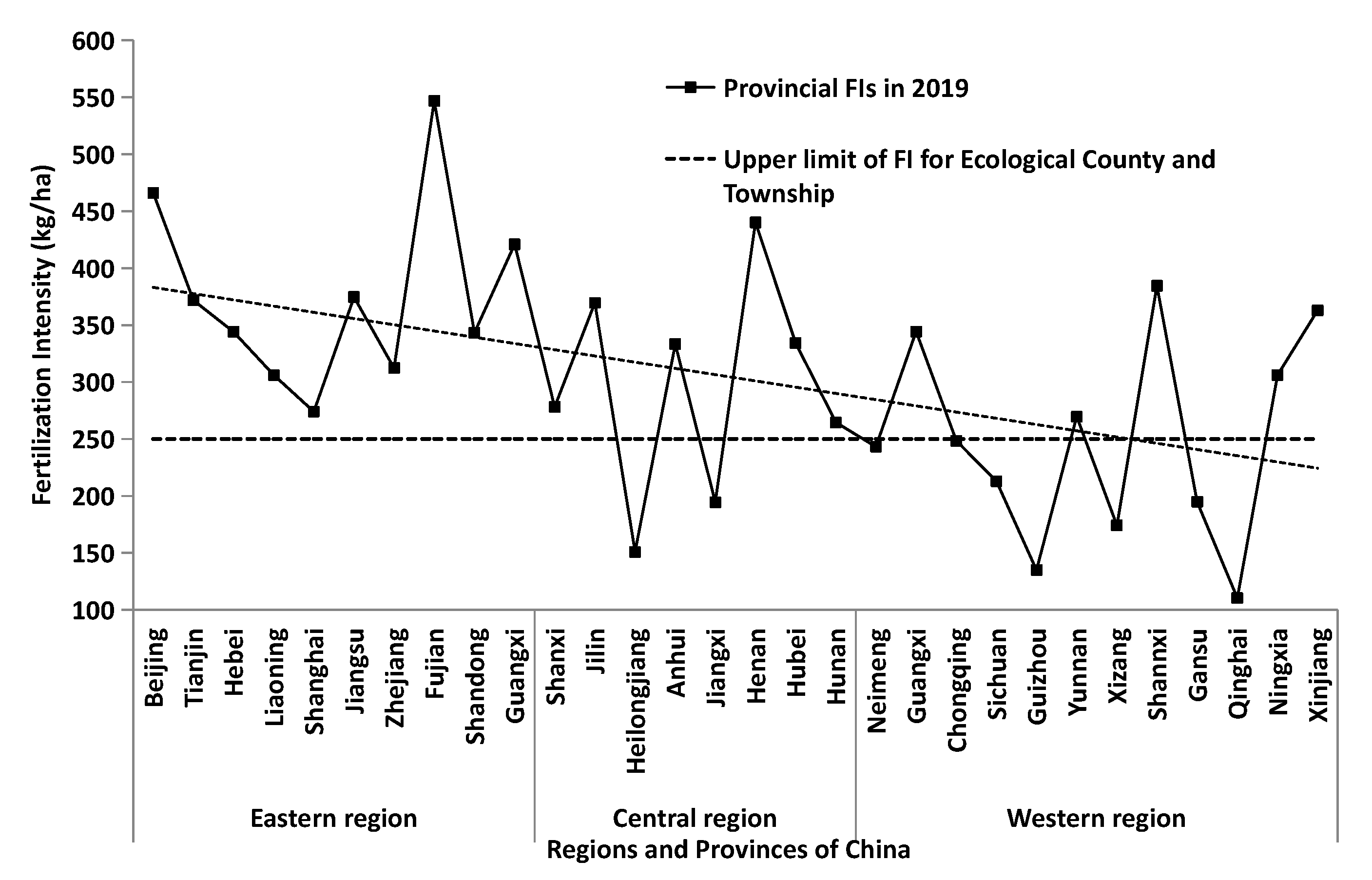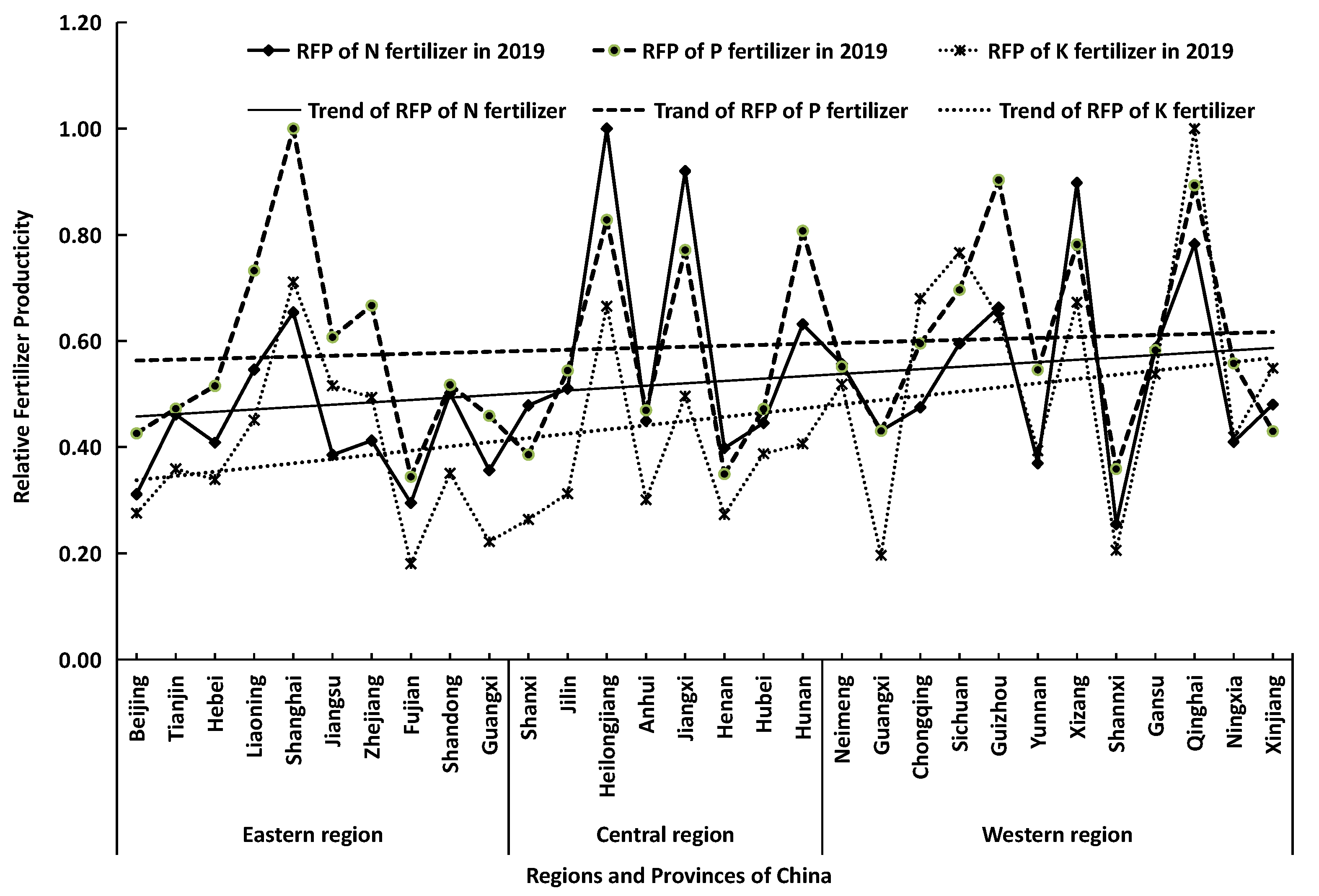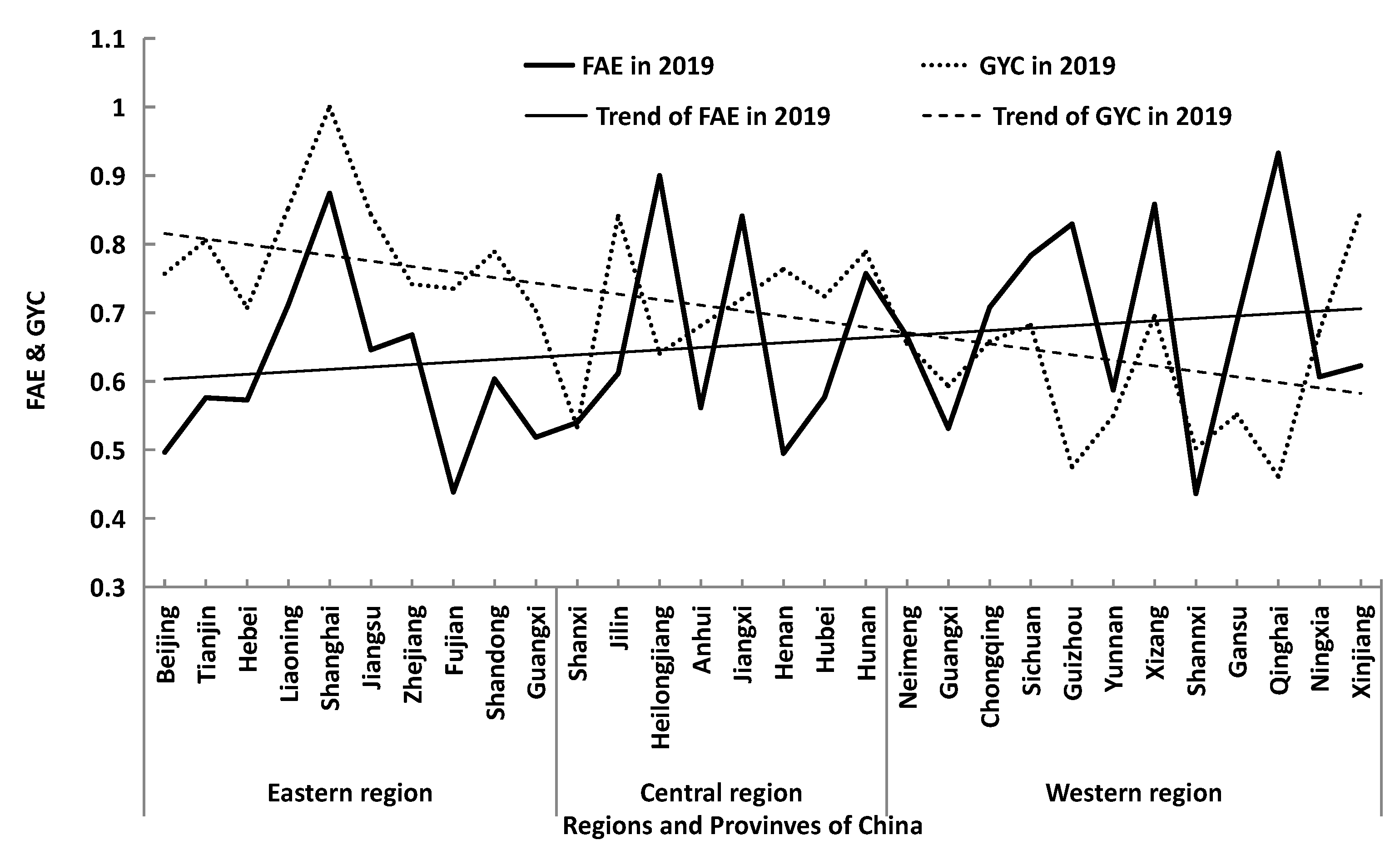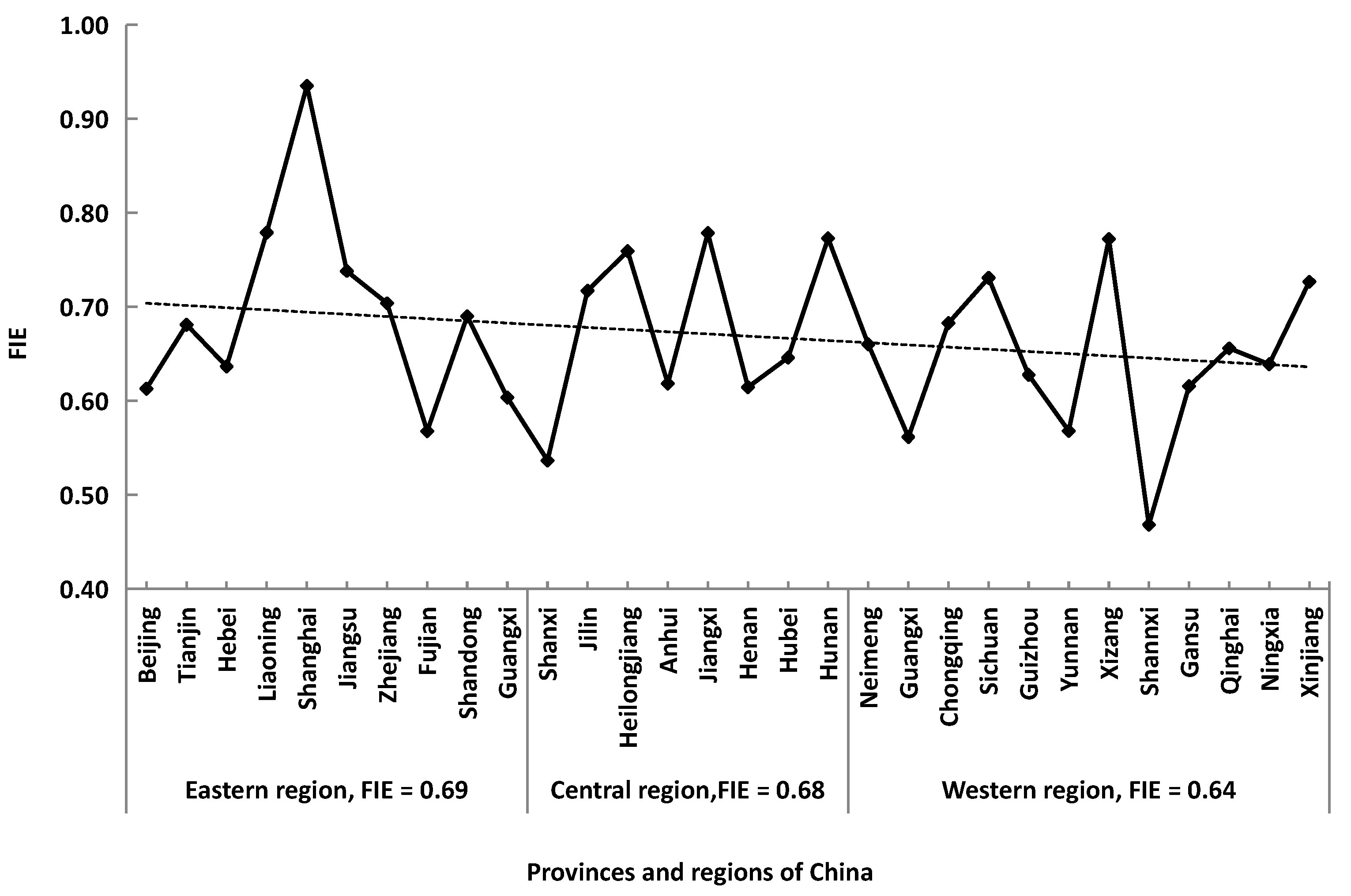Regional Differences and Key Influencing Factors of Fertilizer Integrated Efficiency in China
Abstract
1. Introduction
2. Materials and Methods
2.1. Relative Fertilizer Productivity (RFP)
2.2. Fertilizer Allocation Efficiency (FAE)
2.3. Fertilizer Integrated Efficiency (FIE)
2.4. Gray Correlation Analysis
2.5. Data Source
3. Results
3.1. Regional Differences of Fertilizer Use Efficiency in China
3.1.1. Regional Differences in Fertilization Intensity (FI) in China
3.1.2. Regional Differences in FAE in China
3.1.3. Regional Differences of FIE in China
3.2. Key Factors Influencing Fertilizer Efficiency in China
4. Discussion
5. Conclusions
Author Contributions
Funding
Institutional Review Board Statement
Informed Consent Statement
Data Availability Statement
Conflicts of Interest
References
- National Bureau of Statistics of China. National Data. Available online: http://data.stats.gov.cn/ (accessed on 1 January 2021).
- Zhang, Y.; Liu, W.Z. Analysis and prospects of the green evolution of Chinese farmer’s fertilization policy. Agric. Outlook 2020, 16, 25–29. [Google Scholar]
- Liu, Q.P.; Pu, L.J. Comparation of fertilizer allocation and integrated efficiency between China and major developed countries. Soil Fertil. Sci. China 2021, 6, 328–335. [Google Scholar]
- Wang, P.P.; Han, Y.J.; Zhang, Y. Characteristics of change and influencing factors of the technical efficiency of chemical fertilizer use for agricultural production in China. Resour. Sci. 2020, 42, 1764–1776. [Google Scholar] [CrossRef]
- Yu, L.X.; Zhang, B.; Bai, X.G. Technical efficiency of apple production on Loess Plateau and its influencing factors. J. Arid. Land Resour. Environ. 2018, 32, 68–74. [Google Scholar]
- Cai, X.Y.; Zhang, J.B.; Wang, X. Land fragmentation, cognition of land quality, and efficiency of fertilizer application: Based on a survey data of rice growers in Hubei Province. Res. Agric. Mod. 2021, 42, 869–879. [Google Scholar]
- Shi, C.L.; Zhu, J.F.; Luan, J. Analysis of wheat chemical fertilizer input efficiency and its influencing factors in China—Based on the 15 major wheat producing provinces in China. Agric. Technol. Econ. 2015, 69–78. [Google Scholar] [CrossRef]
- Cai, R.; Chen, P. Does agricultural machinery service improve fertilizer input efficiency: Take wheat as example. J. China Agric. Univ. 2021, 26, 265–274. [Google Scholar]
- Zhu, N.; Ma, J. Measure of chemical fertilizer utilization rate in grain production and its determinants. J. Technol. Econ. 2014, 33, 91–96. [Google Scholar]
- Zhang, B.; Bai, X.G. Fertilizer use efficiency and its affecting factors in apple production in Loess Plateau. J. Arid. Land Resour. Environ. 2017, 31, 55–61. [Google Scholar]
- Liu, Q.; Wu, T.Y.; Tu, W.; Pu, L. Analysis on the changes of fertilization intensity and efficiency in China’s grain production from 1980 to 2019. J. Sci. Food Agric. 2022. [Google Scholar] [CrossRef] [PubMed]
- Liu, Q.; Wu, T.Y.; Pu, L.; Sun, J. Comparison of fertilizer use efficiency in grain production between developing countries and developed countries. J. Sci. Food Agric. 2022, 102, 2404–2412. [Google Scholar] [CrossRef]
- Zhou, F.; Jin, S.T. International Comparison of agricultural fertilizer utilization rate from the perspective of productivity. World Agric. 2016, 4, 35–44. [Google Scholar]
- Zhang, F.S.; Wang, J.Q.; Zhang, W.F.; Cui, Z.L.; Ma, W.Q.; Chen, X.P.; Jiang, R.F. Nutrient use efficiencies of major cereal crops in China and measures for improvement. Acta Pedol. Sin. 2008, 45, 915–924. [Google Scholar]
- Liu, Q.; Sun, J.; Pu, L. Comparatively analysis on fertilization intensity and integrated efficiency in China and Euro-American major countries in 1961—2017. Trans. Chin. Soc. Agric. Eng. (Trans. CSAE) 2020, 36, 9–16. [Google Scholar]
- Tu, Z.G. The coordination of industrial growth with environment and resource. Econ. Res. J. 2008, 2, 93–105. [Google Scholar]
- Dong, W.; Zeng, J.; Wang, Q.; Jiang, X.; Huang, T. Exploration of the profile-effect relationship of Siraitia grosvenorii aqueous extracts related to their laxative effect on the basis of gray correlation analysis. BMC Complement. Med. Ther. 2021, 21, 235. [Google Scholar] [CrossRef]
- Zhang, S.H.; Huang, G.Y.; Zhang, Y.F.; Li, B.J. Screening of key grain production technologies based on gray relational analysis. J. Henan Agric. Univ. 2021, 55, 356–363. [Google Scholar]
- Song, D.P.; Zuo, Q.; Liu, B.S.; Zou, G.Y.; Liu, D.S. Estimation of spatio-temporal variability and health risks of nitrogen emissions from agricultural non-point source pollution: A case study of the Huaihe River Basin, China. J. Agro-Environ. Sci. 2018, 37, 1219–1231. [Google Scholar]
- Liu, X.Y. Study on Nutrients Balance and Requirements in Agricultural Production in China; Chinese Academy of Agricultural Science: Beijing, China, 2018; p. 96. [Google Scholar]
- FAO. FAOSTAT. Data. Available online: http://www.fao.org/faostat/en/#data (accessed on 1 January 2022).
- Wang, S.G.; Liu, Y.; Tian, X.; Yan, B.J. The Estimation of fertilizer use efficiency in agriculture and the improving ways. J. Environ. Econ. 2017, 3, 101–114. [Google Scholar]
- Wang, Z.Y.; Li, G.C.; Zhou, X.S. Structure change of rural labor force, grain production and fertilizer using efficiency promotion: An empirical study based on stochastic frontier production function and Tobit model. J. China Agric. Univ. 2018, 23, 158–168. [Google Scholar]
- Pan, D. The Spatial-temporal difference of driving effects for fertilizer use intensity change and its determinants in China. Econ. Geogr. 2014, 34, 121–126. [Google Scholar]
- Yang, Z.X.; Han, H.Y. Technical efficiency of fertilizer and its influencing factors: Based on wheat and corn empirical study. J. China Agric. Univ. 2011, 16, 140–147. [Google Scholar]
- Zhao, H.Y.; Zhang, Q.w.; Zhou, X.K. Temporal and spatial characteristics of drought in China under climate change. Chin. J. Agrometeorol. 2021, 42, 69–79. [Google Scholar]
- Du, X.D.; Jin, X.B.; Yang, X.L.; Yang, X.H.; Xiang, X.M.; Zhou, Y.K. Spatial-temporal pattern changes of main agriculture natural disasters in China during 1990–2011. J. Geogr. Sci. 2015, 25, 387–398. [Google Scholar] [CrossRef]
- Cao, Y.Q.; Feng, X.X.; Wang, F.; Qi, J.W. Effects of agro-meteorological disasters on the yield of main grain crops in Liaoning Province. J. Catastrophol. 2020, 35, 1–7. [Google Scholar]
- Zhao, Y.N.; Xu, X.; Sun, X.M.; Yan, J.Y.; Huang, Y.F.; Ye, Y.L. GIS-based NPK recommendation and fertilizer formulae for wheat production in different regions of Henan Province. J. Plant Nutr. Fertil. 2021, 27, 938–948. [Google Scholar]
- Zhu, Z.L. On the methodology of recommendation for the application rate of chemical fertilizer nitrogen to crops. Plant Nutr. Fertil. 2006, 12, 1–4. [Google Scholar]
- Ju, X.T. Improvement and validation of theoretical N rate (TNR)----discussing the methods for N fertilizer recommendation. Acta Pedol. Sin. 2015, 52, 249–261. [Google Scholar]
- Sun, Z.; Li, X. Technical efficiency of chemical fertilizer use and its influencing factors in China’s rice production. Sustainability 2021, 13, 1155. [Google Scholar] [CrossRef]
- Department of Planting Management, Minastry of Agriculture and Rural Affairs of China. Guidance on Scientific Fertilization of Main Crops in Spring of 2021. Available online: http://www.moa.gov.cn/gk/nszd_1/2020/202002/t20200226_6337754.htm (accessed on 5 May 2022).
- Yang, L.; Ouyang, H.; Fang, K.; Ye, L.; Zhang, J. Evaluation of regional environmental efficiencies in China based on super-efficiency-DEA. Ecol. Indic. 2015, 51, 13–19. [Google Scholar] [CrossRef]
- Tone, K. A slacks-based measure of efficiency in data envelopment analysis. Eur. J. Oper. Res. 2001, 130, 498–509. [Google Scholar] [CrossRef]
- Cai, R.; Tao, S.M. Spatial difference and dynamic change of agricultural fertilizer input efficiency in China. J. Huazhong Agric. Univ. (Soc. Sci. Ed.) 2020, 6, 57–66. [Google Scholar]
- Ke, Z.J.; Deng, H.H. Analysis on regional differences and convergence of population aging in China. Stat. Decis. Mak. 2021, 19, 68–71. [Google Scholar]
- Wang, X.Q. Current situation of rural population aging and its impact on agricultural economy. World Trop. Agric. Inf. 2021, 11, 85–86. [Google Scholar]
- Li, K.Q.; Ma, D.D. On the investment behavior and decision mechanism of farmers’ fertilizer reduction in ecologically vulnerable regions: Taking 421 households in 4 counties of Shanxi Province as an example. J. Nanjing Agric. Univ. (Soc. Sci. Ed.) 2018, 18, 138–145. [Google Scholar]
- Xu, X. “One belt and one road” cooperation in disaster prevention and mitigation: Challenges and responses. Int. Stud. 2017, 1, 33–43. [Google Scholar]
- Zhang, F.; Hu, H. Study on farmer’s chemical fertilizer input behavior and non-point source pollution. Acta Agric. Jiangxi 2012, 24, 183–186. [Google Scholar]
- Long, F.; Yang, C.Y.; Peng, L.L. An empirical analysis of the impact of natural disasters on grain production in China: Taking rice as an example. Chin. Rural. Econ. 2011, 5, 33–44. [Google Scholar]





| Prov. | Qinghai | Heilongjiang | Shanghai | Xizang | Jiangxi | Guizhou | Sichuan | Hunan | Liaoning | Chongqing |
| FAE | 0.93 | 0.90 | 0.87 | 0.86 | 0.84 | 0.83 | 0.78 | 0.67 | 0.71 | 0.71 |
| Type | Ⅰ | Ⅰ | Ⅱ | Ⅱ | Ⅱ | Ⅱ | Ⅲ | Ⅲ | Ⅲ | Ⅲ |
| Prov. | Gansu | Zhejiang | Neimeng | Jiangsu | Xinjiang | Jilin | Ningxia | Shandong | Yunnan | Hubei |
| FAE | 0.69 | 0.67 | 0.67 | 0.65 | 0.62 | 0.61 | 0.61 | 0.60 | 0.59 | 0.58 |
| Type | Ⅳ | Ⅳ | Ⅳ | Ⅳ | Ⅳ | Ⅳ | Ⅳ | Ⅳ | Ⅴ | Ⅴ |
| Prov. | Tianjin | Hebei | Anhui | Shanxi | Guangxi | Guangdong | Beijing | Henan | Fujian | Shannxi |
| FAE | 0.58 | 0.57 | 0.56 | 0.54 | 0.53 | 0.52 | 0.5 | 0.49 | 0.44 | 0.44 |
| Type | Ⅴ | Ⅴ | Ⅴ | Ⅴ | Ⅴ | Ⅴ | Ⅴ | Ⅴ | Ⅴ | Ⅴ |
| Prov. | Shanghai | Liaoning | Jiangxi | Hunan | Xizang | Heilongjiang | Jiangsu | Sichuan | Xinjiang | Jilin |
| FIE | 0.94 | 0.78 | 0.78 | 0.77 | 0.77 | 0.76 | 0.74 | 0.73 | 0.73 | 0.72 |
| Type | Ⅰ | Ⅲ | Ⅲ | Ⅲ | Ⅲ | Ⅲ | Ⅲ | Ⅲ | Ⅲ | Ⅲ |
| Prov. | Zhejiang | Shandong | Chongqing | Tianjin | Neimeng | Qinghai | Hubei | Ningxia | Hebei | Guizhou |
| FIE | 0.70 | 0.69 | 0.68 | 0.68 | 0.66 | 0.66 | 0.65 | 0.64 | 0.64 | 0.63 |
| Type | Ⅲ | Ⅳ | Ⅳ | Ⅳ | Ⅳ | Ⅳ | Ⅳ | Ⅳ | Ⅳ | Ⅳ |
| Prov. | Anhui | Gansu | Henan | Beijing | Guangdong | Yunnan | Fujian | Guangxi | Shanxi | Shannxi |
| FIE | 0.62 | 0.62 | 0.61 | 0.61 | 0.60 | 0.57 | 0.57 | 0.56 | 0.54 | 0.47 |
| Type | Ⅳ | Ⅳ | Ⅳ | Ⅳ | Ⅳ | Ⅴ | Ⅴ | Ⅴ | Ⅴ | Ⅴ |
| Factors | Expressions | Definition | The Presumed Direction of Influence |
|---|---|---|---|
| PAR | Population aging rate | It indicates the level of social and economic development and is conducive to the intensification of agricultural production. | Positive [23] |
| UR | Urbanization rate | It is the proportion of urban population to total population | Negative [4,24] |
| FIL | Farmer income level | It is expressed as RMB Yuan per capita of farmers’ disposable income. | Positive or Negative [25] |
| MCI | Multiple cropping index | It is expressed as the ratio of crop sowing area to cultivated land area. | Positive |
| FS | Farming scale | It is measured by the cultivated land per capita of rural population. | Positive |
| EIR | Effective irrigation rate | It is expressed as the ratio of irrigation area to cultivated land area. | Positive |
| DDR | Disaster damaged rate | It is the ratio of disaster damaged area to affected area, i.e. disaster intensity [26,27] | Negative |
| DAR | Disaster affected rate | It is expressed as the ratio of the disaster affected area of crops to the sown area of crops [28] | Negative |
| Factors | Gray Correlation Analysis | Pearson Correlation Analysis | |||||
|---|---|---|---|---|---|---|---|
| γi | CW (%) | Rank | Pearson corr. | Sig. | Rank | ||
| DAR | 0.979 | 0.136 | 14 | 1 | −0.364 ** | 0.044 | 3 |
| PAR | 0.975 | 0.135 | 27 | 2 | 0.344 * | 0.058 | 4 |
| DDR | 0.966 | 0.134 | 40 | 3 | −0.302 * | 0.099 | 5 |
| EIR | 0.952 | 0.132 | 54 | 4 | 0.425 ** | 0.017 | 1 |
| FIL | 0.925 | 0.128 | 66 | 5 | 0.176 | 0.343 | 7 |
| MCI | 0.894 | 0.124 | 79 | 6 | 0.377 ** | 0.037 | 2 |
| FS | 0.766 | 0.106 | 89 | 7 | 0.267 | 0.147 | 6 |
| UR | 0.764 | 0.106 | 100 | 8 | 0.097 | 0.605 | 8 |
| Crops | Regions | Provinces | YT (kg hm−2) | FIs (kg hm−2) |
|---|---|---|---|---|
| Rice | Northeast | Jilin, Liaoning and some parts of Neimeng | <7500 | N: 104–133, P: 46–58, K: 40–50 |
| Upper Yangtze River | East Sichuan, Chongqing, South Shaanxi, etc. | >9750 | N: 180–210, P: 60–90, K: 75–120 | |
| Middle Yangtze River | Anhui, Northeast Hunan, North Jiangxi, etc. | >8250 | N: 150–180, P: 60–105, K: 60–120 | |
| Lower Yangtze River | Jiangsu, North Zhejiang | >9000 | N: 180–270, P: 75–90, K: 90–120 | |
| Winter wheat | North China Plain irrigated | Shandong, Tianjin, part of Hebei, etc. | — | N: 68–88 |
| Middle & Lower Yangtze | Hubei, Hunan, Jiangxi, Zhejiang, Shanghai, etc. | 6000–8250 | N: 68–81 with some KCI | |
| Spring wheat | Northwest irrigated area | Xinjiang, Central Neimeng, North Ningxia, etc. | 6000–8250 | N: 158–211, P: 81–95, K: 45–53 |
Publisher’s Note: MDPI stays neutral with regard to jurisdictional claims in published maps and institutional affiliations. |
© 2022 by the authors. Licensee MDPI, Basel, Switzerland. This article is an open access article distributed under the terms and conditions of the Creative Commons Attribution (CC BY) license (https://creativecommons.org/licenses/by/4.0/).
Share and Cite
Liu, Q.; Tu, W.; Pu, L.; Zhou, L. Regional Differences and Key Influencing Factors of Fertilizer Integrated Efficiency in China. Sustainability 2022, 14, 12974. https://doi.org/10.3390/su142012974
Liu Q, Tu W, Pu L, Zhou L. Regional Differences and Key Influencing Factors of Fertilizer Integrated Efficiency in China. Sustainability. 2022; 14(20):12974. https://doi.org/10.3390/su142012974
Chicago/Turabian StyleLiu, Qinpu, Wei Tu, Lijie Pu, and Li Zhou. 2022. "Regional Differences and Key Influencing Factors of Fertilizer Integrated Efficiency in China" Sustainability 14, no. 20: 12974. https://doi.org/10.3390/su142012974
APA StyleLiu, Q., Tu, W., Pu, L., & Zhou, L. (2022). Regional Differences and Key Influencing Factors of Fertilizer Integrated Efficiency in China. Sustainability, 14(20), 12974. https://doi.org/10.3390/su142012974





